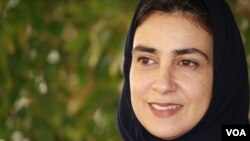For women’s rights activists in Saudi Arabia, this year began with a thump.
It was going to be an exciting new era in Saudi Arabia — one in which women voted in elections and held office. Of the nearly 1,000 local council members elected in late 2015, roughly 20 of them were women for the first time ever.
But the moment was dulled when at least two of the female representatives tried to sit in council in the same room, at the same table, with their male counterparts. Some of the men said mixed-gender meetings are counter to Islamic law, a point liberals in Saudi Arabia hotly debate.
A couple of weeks later, Lama al-Sulaiman, one of the newly elected representatives and former Jeddah Chamber of Commerce vice-chair was on social media and in the press, the debate was raging about the unresolved issue of seats, but she was reserved.
“There is a pool of people that are more conservative and believe men and women should be segregated,” she explained. “And then you have a more moderate conservative that believe[s] men and women should be able to mix, especially on leadership positions or in decision-making positions.”
Activists on both sides of the debate were more forceful. Samar Fatany, a commentator for the Saudi Gazette wrote: “Women have had enough of this extremist nonsense.”
Meanwhile, Twitter users lamented a decline of morals in their society.
“The women are sad because they can’t sit next to the men?” tweeted a user named Salah. “How can a mentality like this be developing in our country?”
Restrictions
The tangle over the seats, according to al-Sulaiman, is part of a larger battle for women’s empowerment in Saudi Arabia.
Women in Saudi Arabia face significant restrictions, like needing permission from male guardians to travel, go to school and hold certain kinds of jobs. In general, mixing between unmarried or unrelated men and women is strictly forbidden. Earlier this week 11 people—including men and women—were reportedly arrested in Jeddah for having a mixed-gender beach party that served alcohol, which is also banned.
Women are forbidden to drive in Saudi Arabia and are required to wear lose fitting gowns over their clothes called abayas.
But these restrictions, according to al-Sulaiman, are secondary to larger problems, like the small number of women in the workforce and the control men have over their female “dependents” finances.
“Challenges are realities,” she said.“The will to change them is there. We win some. We fail some. But at the end, you know, we are moving forward.”
Segregation is the Norm
At a mega-shopping mall in Riyadh, 17-year-old Selma told us that Facebook is too old-fashioned for her, but she still uses Twitter. But separating genders in schools, she said, is not old-fashioned — just common sense.
“I’ve heard even in the West they are going to stop mixing genders,” she continued, “Because it causes so many problems.”
Men and women in Saudi Arabia usually eat at different restaurants, frequent different shops and enter buildings by different doors. Schools and workplaces usually have separate places for men and women.
But when local municipal councils opened early this year, only Jeddah had a problem with the new dual-gender bodies. In some places, women sat comfortably in the same room with the men; in others, the women wished to appear at council meetings electronically.
The controversy in Jeddah was a surprise to many, according to Abdulaziz Sager, the chairman of the Gulf Research Center in Jeddah, because the 30 female members of the national Shoura (consultative) Council, the country’s highest religious body, have long shared a room with their male colleagues.
“A lot of the Shoura members are women,” he said. “And they are in the same hall.”
Other commentators said because the Saudi government had declared that women could work with men in the same room on the Shoura Council, the complaints in Jeddah were “tantamount to objecting to the King’s decision.”
Women in Workforce
While many in Saudi Arabia say elected representatives should share unsegregated spaces, dismantling the system is not on the table. For example, desegregating workplaces could discourage women from joining the work force, by creating hostile atmospheres for many women and their families.
More than half the Saudi population — both men and women — prefer to work in a segregated place, according to a recent survey of 3,000 people, said al-Sulaiman. Getting more women to work requires creating more female-only spaces, she continued.
“I cannot bring in a woman and impose on her to mix with men when she has never mixed with men all her life,” she said.“It is traumatizing.”
Saudi women make up about 16 percent of the workforce, according to John Sfakianakis, who has advised the Saudi government and serves as chief economist for several Saudi banks.The number is small, he said, but a significant leap from 2003, when it was about 9 percent.
“It is a significant increase if you take into account that this is a very different culture,” he explained.“And within a very short period of time it has nearly doubled.”








